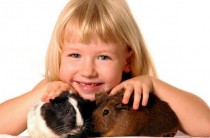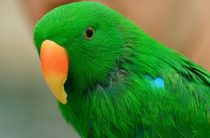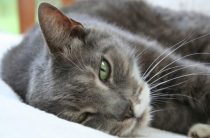It is no secret to anyone that in recent years, cases of allergies have increased significantly, especially among the urban population. It is erroneous to think that allergies are a congenital disease. Each of us can “earn” this disease at a certain stage of life. Adults often suffer from hay fever and food allergies. But children are much more susceptible to any of the species. In babies, it begins after the fulfillment of their request for a little furry friend - a kitten. And here parents should be patient to explain to their child that in his case a cat is not the best idea.
Causes of Cat Allergies
Many are accustomed to believing that it is the cat's fur that provokes allergic reactions. I would like to dispel this myth. An allergy to cats in children and adults is caused by a protein that is produced by the cat's body. And the pet, in the course of its life, spreads it throughout the room: walls, furniture, carpeting, dishes. This protein is excreted in saliva and urine. Provocateurs can also be dead skin cells of an animal that spread in the air. From this follows the conclusion that even the acquisition of a kitten of a hairless breed will not save your baby from allergies.
In addition, if a cat is allowed to walk outside, it can bring other types of allergies. For example pollinosis - plant pollen and street dust remains on the paws and skin of the animal. Scientists have proven that the presence of a cat in the house from the very birth of the baby provokes the rapid production of antibodies to the allergen in his body and, already at an older age, the child in 30% of the case will not suffer from allergies. But, as you can see, this rule does not always work.
Allergy symptoms
A cat allergy manifests itself in your child's violent bouts of coughing, accompanied by nasal congestion, sneezing, and watery eyes. Quite often, the disease manifests itself in the form of dermatitis, urticaria or a rash in the form of blisters. The child may also complain of a sore throat. If you notice swelling and redness in your baby in the area of scratches that do not heal for a long time, this is the first “bell” about the disease.
In addition to all this, other childhood diseases can worsen, such as atopic dermatitis, which is quite common in childhood. Sometimes cat allergies are seasonal. With the onset of flowering plants, all symptoms intensify. Body temperature may rise and shortness of breath may appear. This is dangerous because it can lead to anaphylactic shock or bronchial asthma, which is almost impossible to get rid of.
Treatment of cat allergy in children
Before you start any therapeutic intervention, you need to make sure that your diagnosis is correct. After all, such symptoms in children can manifest themselves in anything. To do this, try isolating the cat for a few days and not letting the baby come into contact with other animals. For a couple of days of such ignoring, the manifestations of allergies should disappear. If such a moment has not come, allergy provocateurs can be house flowers, food, household chemicals or room dust.
In order not to put your child at risk, contact an allergist or pediatrician. It will help you choose the right therapy after the results of the tests. Blood tests and skin tests are ordered. Allergy to cats in children is treated as standard: antihistamines, nasal and eye drops. Many antihistamines are sold in pharmacies without a prescription:
| Tavegil | The drug is allowed to be used by children of any age. It is used for various allergic manifestations. It retains the therapeutic effect for quite a long time and does not have a pronounced sedative effect. Refers to the drugs of the first generation. |
| Diazolin | Relieves symptoms of animal allergies and hay fever quite well. It is prescribed to children of different ages in appropriate doses. Almost no side effects. |
| Suprastin | For use by children over 6 months of age. It has a strong antihistamine effect, but has a number of adverse reactions such as drowsiness, lethargy, headache, dry mucous membranes, and heart rhythm disturbances. |
| Peritol | It has a strong effect on allergens. Eliminates allergic symptoms in a short time. Adverse reactions are possible in rare cases with individual intolerance to the components of the drug. Children under 2 years of age are not allowed. |
| Zyrtec | It copes with allergies both at an early stage and in advanced cases. Effectively facilitates breathing, eliminates conjunctivitis. Does not cause drowsiness and addiction. Refers to the drugs of the second generation. Babies are allowed from 6 months. It helps a lot with a disease such as an allergy to a cat. |
| Claritin | Allowed for children from the age of two. Eliminates such manifestations of the disease as rhinitis, conjunctivitis, cough. It has no adverse reactions other than individual intolerance to the individual components of the drug. |
To save your baby from allergic rhinitis, you can use nasal remedies that will help from the very first minutes. These drugs are divided into:
- Vasoconstrictor;
- Hormonal;
- Anti-inflammatory;
- Means for washing the nose.
At the initial stage of the manifestation of allergies, children are prescribed vasoconstrictor drops. They contribute to the rapid removal of sputum, and with it, allergens that have accumulated on the mucous membrane of the nasal cavity. As a result of the barrier they create, allergens are no longer able to provoke the immune system. But it is worth remembering that taking such drugs for more than five days is strictly prohibited. Such actions can be addictive, mucosal irritation, nosebleeds.
Vasoconstrictor drops approved for children include:
|
|
To relieve swelling and inflammation, anti-inflammatory nasal drugs are used:
| Polydex | The drug is an antibiotic. Quickly facilitates breathing and frees the nasal cavity from phlegm. It has anti-allergic and anti-edematous effect. Children are allowed at the age of at least 2.5 years. |
| Bioparox | The drug does not have a vasoconstrictor effect. Has a wide spectrum of action. Prohibited for children under three years of age. |
| Protargol | The drug contains silver ions. It is an antibacterial agent. Silver has anti-inflammatory properties. It is applied in the form of a solution. Recommended for children over two years old. |
| Isofra | Children are assigned from one year of age. The result comes quickly enough. Therefore, if the effect does not occur within three days, the drug should be changed. |
The safest drug in this group is Pinosol. It contains in its composition oil of mint, eucalyptus, propolis and pine. Effectively soften the nasal mucosa. They prevent the penetration of allergens into the body through the upper respiratory tract. But children under three years old are prohibited.
Means for washing the nose are allowed for children from birth. They are absolutely harmless due to their composition, which includes only sea salt and water or saline. Such drugs effectively clean the upper respiratory tract, promote healing of the mucous membrane. They do not have any side effects and are not addictive. Means prevent the reproduction of pathogenic microorganisms. These include: Aquamaris, Salin, Marimer, Aqualor and others.
A nasal wash can be prepared at home. Take one tablespoon of salt (ordinary rock or sea salt) and dilute it in a glass of hot water. Rinse your child's nose with this solution in the morning and at bedtime. For such manipulations, a simple saline solution is also used.
Hormonal drops are prescribed in case of inaction of other means. Such drugs are produced only in the form of a spray, since the drops are difficult to dose, and in this case, exceeding the amount is fraught with sad consequences. For children older than two years, they are prescribed exclusively for allergic rhinitis. At a younger age, the use is prohibited. The most common hormonal sprays are Avamys and Nasonex.
Recently, doctors have begun to treat allergies with immunotherapy. The result of such treatment is observed in 80% of patients. The essence of this method is the introduction of small doses of the allergen. Gradually, they increase, and the body gets used to it. It begins to produce antibodies and ceases to react violently to wool and other allergens. The disadvantage is that injections are carried out twice a week, and children are allowed at least five years of age. Another disadvantage is that getting rid of allergies occurs within 3-5 years.
Prevention
To prevent the appearance of such a disease as cat allergy in your baby, it is necessary to eliminate the allergen - a pet. And in every possible way to prevent the contact of the child with other cats. If there is no possibility and desire to give away your pet, and a child’s cat allergy manifests itself superficially and without complications, you can listen to the following tips and facts.
Scientists have found that cats with dark hair are less likely to cause
allergies than light-haired pets. As for the sex of the kitten, cats are more likely to be the causative agents of the disease than cats. It will not be superfluous to resort to castration or sterilization. Be sure to ventilate the room and carry out regular wet cleaning. We also recommend getting an air conditioner, purifier or humidifier.
Try, anyway, to minimize the contact of the child with the cat. Keep all cat accessories (bowl, toys, toilet) in another room where the child is not. Get rid of any carpeting. It is better to cover the floor with linoleum or laminate. It is also recommended to remove all upholstered furniture and items made of wool. After each contact with the cat, wash your hands thoroughly and wash the child, change clothes immediately into clean clothes.
It is important to properly feed the cat with quality food. And when bathing an animal, use only hypoallergenic shampoo. Any manifestation of an allergy in a child indicates a reduced immunity. Therefore, it is necessary to work on strengthening it.











